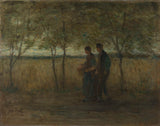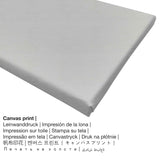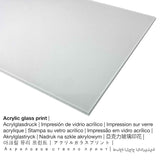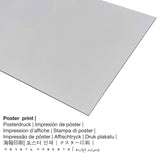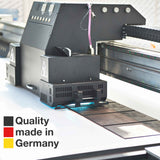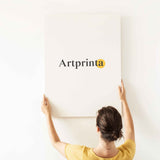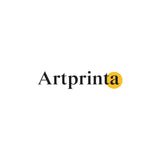Jozef Israëls, 1860 - Nlegharị anya n'ụlọ - mbipụta nka mara mma
Ụtụ gụnyere. Mbupu gbakọrọ na ndenye ọpụpụ.
Họrọ ngwa ngwaahịa masịrị gị
Na nhọrọ mwepu ngwaahịa ị nwere ike họrọ nha na akụrụngwa nke gị. Nha na ihe ndị a bụ nhọrọ anyị na-enye gị maka nkeonwe:
- Mbipụta akwụkwọ mmado (ihe kwaaji): Our poster print is a printed sheet of canvas with a fine finish on the surface. It is particularly designed for putting your fine art print in a custom frame. Please bear in mind, that depending on the size of the canvas poster print we add a white margin of around 2-6cm round about the artwork to facilitate the framing with your custom frame.
- Bipụta na iko acrylic na-egbuke egbuke (nke nwere ezigbo mkpuchi iko): A glossy print on acrylic glass, which is often named as a plexiglass print, will convert your favorite artwork into wonderful home décor. The work of art will be manufactured with state-of-the-art UV direct printing machines. Our plexiglass protects your custom fine art print against light and external influences for many years.
- Mbipụta kwaaji: The printed canvas stretched on a wooden frame. Additionally, a canvas produces a soft and pleasing impression. How do I hang a canvas print on the wall? The great advantage of canvas prints is that they are relatively low in weight, which implies that it is easy and straightforward to hang up your Canvas print without any wall-mounts. That is why, canvas prints are suitable for all kinds of walls.
- Mbipụta nke aluminom: These are metal prints on aluminium dibond material with a true effect of depth, which creates a modern impression throuch a surface structure, that is non-reflective. The Aluminium Dibond Print is the best start to art reproductions made with aluminum. The bright & white sections of the artpiece shimmer with a silky gloss, however without any glare. Colors are vivid and luminous in the highest definition, the details of the print are crisp and clear.
Ederede iwu: We try in order to depict the products as closely as possible and to showcase them visually in our shop. Nonetheless, the colors of the printing material, as well as the imprint might differ marginally from the presentation on the screen. Depending on your screen settings and the nature of the surface, not all color pigments can be printed as exactly as the digital version. Bearing in mind that all the fine art prints are printed and processed by hand, there might also be minor discrepancies in the motif's exact position and the size.
(© - site na Rijksmuseum - www.rijksmuseum.nl)
"House Waart Times. A young farmer and his wife run into the evening on a path among trees along a cornfield. The woman carrying a basket on the arm.
Nkọwapụta akụkọ
Theurning homewards is an artpiece made by Jozef Israëls in 1860. It is part of the collection of Rijksmuseum, nke bụ nnukwu ihe ngosi nka maka nka na akụkọ Dutch site na Middle Ages ruo ugbu a. Nke nkà nke oge a masterpiece, nke bụ akụkụ nke ọha ngalaba na-gụnyere n'ikike nke Rijksmuseum.: . Ọzọkwa, nhazi nke mmepụta dijitalụ dị n'ime odida obodo format ma nwee oke nke 4: 3, nke pụtara na ogologo bụ 33% ogologo karịa obosara. The painter Jozef Israëls was a European artist, whose art style was mainly Historicism. The European painter was born in the year 1824 in Groningen,Netherlands and died at the age of 87 na 1911.
Data ndabere na ọrụ nka
| Aha ọrụ nka: | "Theurning homewards" |
| nhazi ọkwa: | sere |
| Okwu mkpokọta: | nkà nke oge a |
| Century: | 19th narị afọ |
| Emepụtara n'afọ: | 1860 |
| Afọ nka: | ihe dị ka afọ 160 |
| Egosiputara na: | Rijksmuseum |
| Ebe ngosi nka: | Amsterdam, Netherlands |
| Weebụsaịtị nke ihe ngosi nka: | Rijksmuseum |
| Ụdị nka nka: | ngalaba ọha |
| Site n'aka: | Rijksmuseum |
Nkọwa ngwaahịa ahaziri ahazi
| Ụdị edemede: | ezi nka mmeputakwa |
| Mmeputakwa: | dijitalụ mmeputakwa |
| Production usoro: | mbipụta dijitalụ (Mbipụta UV ozugbo) |
| Mmalite nke ngwaahịa a: | arụpụtara na Germany |
| Ụdị ngwaahịa: | mmepụta ihe na-achọ |
| Ojiji ngwaahịa: | mgbidi mgbidi, nka mgbidi |
| Ntuziaka onyonyo: | nhazi odida obodo |
| Ụdị anya: | 4: 3 |
| Nkọwa nke oke akụkụ: | ogologo bụ 33% ogologo karịa obosara |
| Ụdị dị iche iche dị: | Mbipụta kwaaji, mbipụta enyo acrylic (nwere ezigbo mkpuchi iko), mbipụta akwụkwọ mmado (akwụkwọ kwaaji), mbipụta ọla (aluminium dibbond) |
| Mbipụta kanvas (akwa akwa na etiti ihe ndọtị): | 40x30cm - 16x12", 80x60cm - 31x24", 120x90cm - 47x35", 160x120cm - 63x47" |
| Mbipụta iko acrylic (nwere ezigbo mkpuchi iko) nhọrọ nha: | 40x30cm - 16x12", 80x60cm - 31x24", 120x90cm - 47x35" |
| Nhọrọ nha nke akwụkwọ mmado (akwụkwọ kwaaji): | 40x30cm - 16x12", 80x60cm - 31x24", 120x90cm - 47x35" |
| Mbipụta aluminom (aluminium dibond ihe) dị iche iche: | 40x30cm - 16x12", 80x60cm - 31x24", 120x90cm - 47x35" |
| Nhazi mbipụta nka: | adịghị |
Ozi omenkà Contextal
| Aha onye nka: | Jozef Israel |
| Gender: | nwoke |
| Nationality: | Dutch |
| Ọrụ nke onye na-ese ihe: | onye na-ese ihe |
| Country: | mba netherland |
| Otu nka: | omenkà nke oge a |
| styles: | Akụkọ ihe mere eme |
| Afọ ọnwụ: | 87 afọ |
| Amụrụ n'afọ: | 1824 |
| Ebe amụrụ onye: | Groningen, Netherlands |
| Afọ ọnwụ: | 1911 |
| Ebe ọnwụ: | Scheveningen, Netherlands |
© nwebiisinka | Artprinta.com

